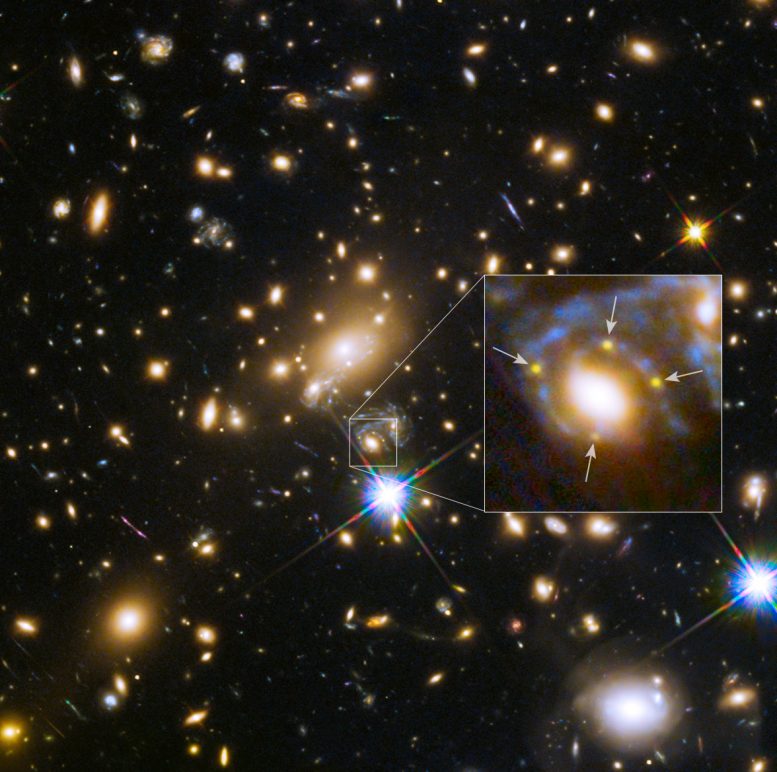
This image shows the huge galaxy cluster MACS J1149+2223, whose light took over 5 billion years to reach us. The huge mass of the cluster and one of the galaxies within it is bending the light from a supernova behind them and creating four separate images of it. The light has been magnified and distorted due to gravitational lensing and as a result the images are arranged around the elliptical galaxy in a formation known as an Einstein cross. A close-up of the Einstein cross is shown in the inset. Credit: NASA, ESA, S. Rodney (John Hopkins University, USA) and the FrontierSN team; T. Treu (University of California Los Angeles, USA), P. Kelly (University of California Berkeley, USA) and the GLASS team; J. Lotz (STScI) and the Frontier Fields team; M. Postman (STScI) and the CLASH team; and Z. Levay (STScI)
Using the Hubble Space Telescope, a team of astronomers has spotted four images of a distant exploding star for the first time. The images are arranged in a cross-shaped pattern by the powerful gravity of a foreground galaxy embedded in a massive cluster of galaxies.
The supernova discovery paper appears in a special issue of Science celebrating the centenary of Albert Einstein’s theory of general relativity.
Whilst looking closely at a massive elliptical galaxy and its associated galaxy cluster MACS J1149+2223 — whose light took over 5 billion years to reach us — astronomers have spotted a strange and rare sight. The huge mass of the galaxy and the cluster is bending the light from a much more distant supernova behind them and creating four separate images of it. The light has been magnified and distorted due to gravitational lensing [1] and as a result the images are arranged around the elliptical galaxy in a formation known as an Einstein cross.
Although astronomers have discovered dozens of multiply imaged galaxies and quasars, they have never before seen multiple images of a stellar explosion.
This animation shows how the huge galaxy cluster MACS J1149+2223 — whose light took over 5 billion years to reach us — bends the light from a supernova lying behind the cluster so that Hubble captures four images of the supernova.
“It really threw me for a loop when I spotted the four images surrounding the galaxy — it was a complete surprise,” said Patrick Kelly of the University of California Berkeley, USA, a member of the Grism Lens Amplified Survey from Space (GLASS) collaboration and lead author on the supernova discovery paper. He discovered the supernova during a routine search of the GLASS team’s data, finding what the GLASS group and the Frontier Fields Supernova team have been searching for since 2013 [2]. The teams are now working together to analyze the images of the supernova, whose light took over 9 billion years to reach us [3].
“The supernova appears about 20 times brighter than its natural brightness,” explains the paper’s co-author Jens Hjorth from the Dark Cosmology Center, Denmark. “This is due to the combined effects of two overlapping lenses. The massive galaxy cluster focuses the supernova light along at least three separate paths, and then when one of those light paths happens to be precisely aligned with a single elliptical galaxy within the cluster, a secondary lensing effect occurs.” The dark matter associated with the elliptical galaxy bends and refocuses the light into four more paths, generating the rare Einstein cross pattern the team observed.
This unique observation will help astronomers refine their estimates of the amount and distribution of dark matter in the lensing galaxy and cluster. There is more dark matter in the Universe than visible matter, but it is extremely elusive and is only known to exist via its gravitational effects on the visible Universe, so the lensing effects of a galaxy or galaxy cluster are a big clue to the amount of dark matter it contains.
When the four supernova images fade away as the explosion dies down, astronomers will have a rare chance to catch a rerun of the explosion. The supernova images do not arrive at the Earth at the same time because, for each image produced, the light takes a different route. Each route has a different layout of matter — both dark and visible — along its path. this causes bends in the road, and so for some routes the light takes longer to reach us than for others. Astronomers can use their model of how much dark matter is in the cluster, and where it is, to predict when the next image will appear as well as using the time delays they observe to make the mass models even more accurate [4].
“The four supernova images captured by Hubble appeared within a few days or weeks of each other and we found them after they had appeared,” explains Steve Rodney of Johns Hopkins University, USA, leader of the Frontier Fields Supernova team. “But we think the supernova may have appeared in a single image some 20 years ago elsewhere in the cluster field, and, even more excitingly, it is expected to reappear once more in the next one to five years — and at that time we hope to catch it in action.”
The supernova has been nicknamed Refsdal in honor of Norwegian astronomer Sjur Refsdal, who, in 1964, first proposed using time-delayed images from a lensed supernova to study the expansion of the Universe. “Astronomers have been looking to find one ever since,” said Tommaso Treu of the University of California Los Angeles, USA, the GLASS project’s principal investigator. “And now the long wait is over!”
Notes
- Gravitational lensing was first predicted by Albert Einstein. This effect is similar to a glass lens bending light to magnify and distort the image of an object behind it.
- The Frontier Fields is a three-year program that uses Hubble to observe six massive galaxy clusters to probe not only what is inside the clusters but also what is beyond them through gravitational lensing. The GLASS survey uses Hubble’s capabilities to study remote galaxies using ten massive galaxy clusters as gravitational lenses, including the six in the Frontier Fields.
- The team used the W. M. Keck Observatory on Mauna Kea, in Hawaii, to measure the redshift of the supernova’s host galaxy, which is a proxy for its distance.
- Measuring the time delays between images offers clues to the type of warped-space terrain the supernova’s light had to cover and will help the astronomers fine tune the models that map out the cluster’s mass.
Reference: “Multiple images of a highly magnified supernova formed by an early-type cluster galaxy lens” by Patrick L. Kelly, Steven A. Rodney, Tommaso Treu, Ryan J. Foley, Gabriel Brammer, Kasper B. Schmidt, Adi Zitrin, Alessandro Sonnenfeld, Louis-Gregory Strolger, Or Graur, Alexei V. Filippenko, Saurabh W. Jha, Adam G. Riess, Marusa Bradac, Benjamin J. Weiner, Daniel Scolnic, Matthew A. Malkan, Anja Von Der Linden, Michele Trenti, Jens Hjorth, Raphael Gavazzi, Adriano Fontana, Julian C. Merten, Curtis Mccully, Tucker Jones, Marc Postman, Alan Dressler, Brandon Patel, S. Bradley Cenko, Melissa L. Graham and Bradley E. Tucker, 6 March 2015, Science.
DOI: 10.1126/science.aaa3350
arXiv: 1411.6009


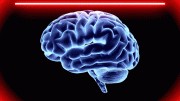
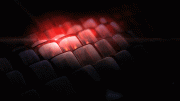


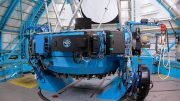
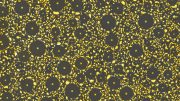
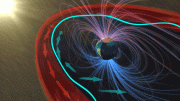
So, we can conclude that Dark Matter is responsible for this explosion. Dark Matter is responsible for the galactic revolution of our Milky Way galaxy in multiple strands of arcs revolving in a globular or flat galaxy. Dark Matter is the energy spread in between the visible matter of stars and galaxies, in various lumps and to the extent of 96% of the Universal masses. It is playing kaleidoscopic effect on the visible stars and galaxies by gravitational lensing and universe expansion in a paraboloid. Dark Matter should consist of non-cohesive fundamental particles yet to be identified which are lumped only by gravity.. The force may be both gravitational and anti-gravitational and the non-binding bosons of Higgs may be a constitutional part of it. Thank You.